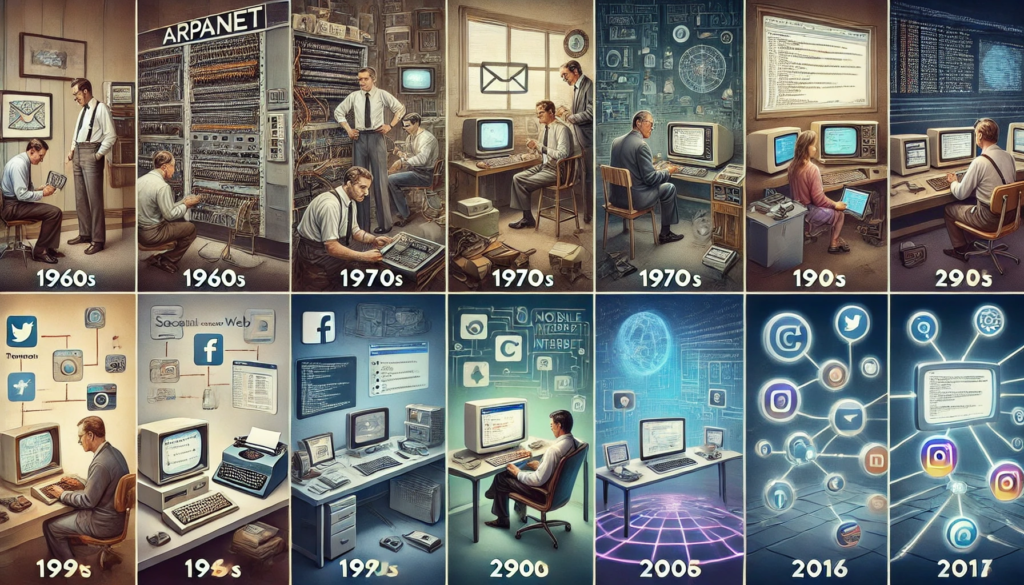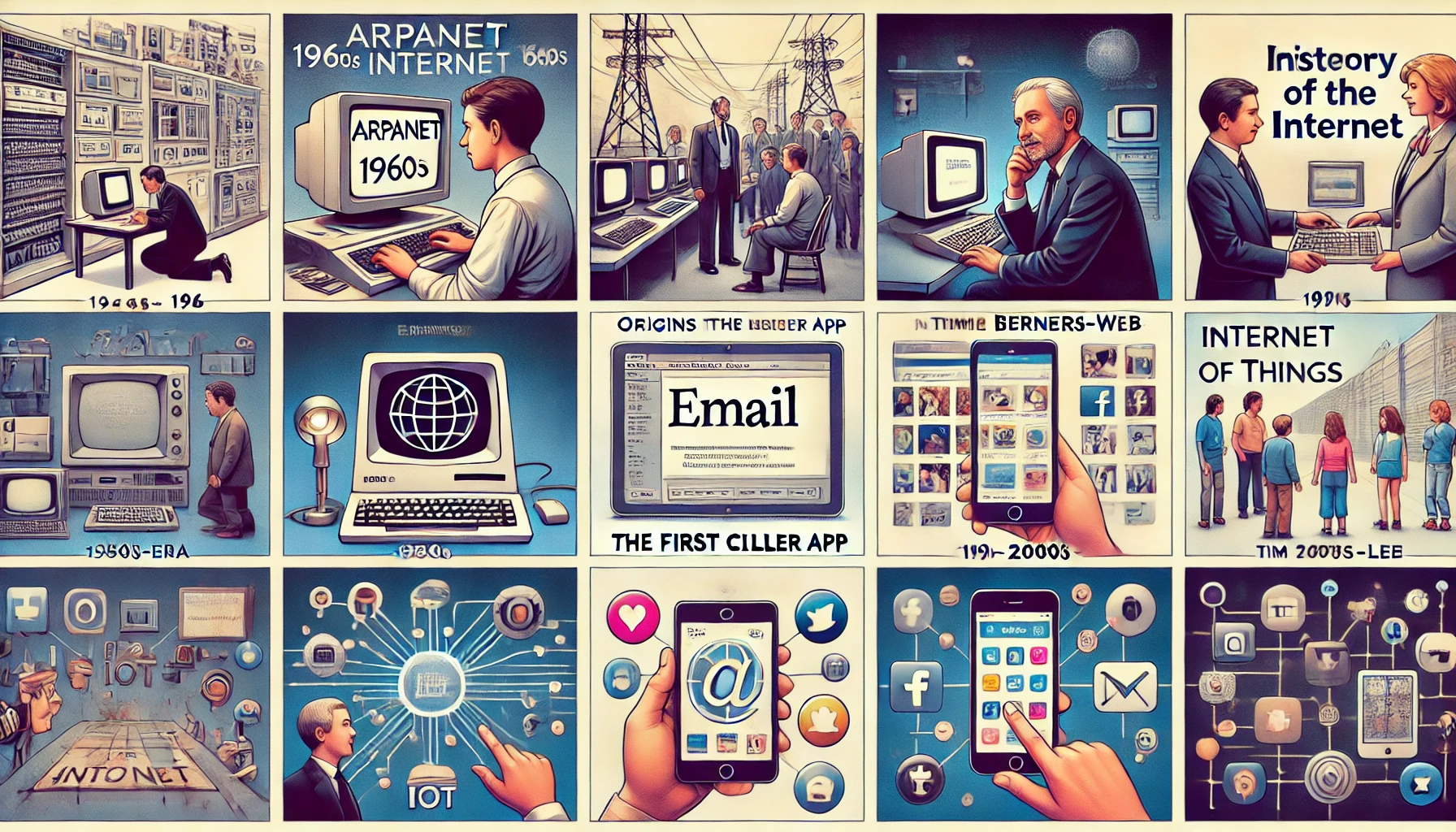Explore the incredible history of the internet, tracing its origins from ARPANET to the World Wide Web and today’s digital landscape. Learn about key innovations, the rise of social media, and the future of online connectivity in this comprehensive guide.
The History of the Internet
The internet has become one of the most transformative forces in human history, influencing nearly every aspect of modern life. From its modest beginnings as a government project, the internet has evolved into a global network connecting billions of people, reshaping communication, commerce, entertainment, and more. Understanding the history of the internet offers valuable insight into its current role and potential future.
Origins of the Internet
The origins of the internet date back to the 1960s, a period marked by the Cold War, where communication and information security became paramount. Researchers in the United States sought ways to build a resilient communication network that could withstand interruptions and maintain reliable connections across long distances. This led to the development of various networking technologies, ultimately culminating in the creation of the internet.
The Early Concept of Networking
In the early 1960s, visionaries like J.C.R. Licklider from the Massachusetts Institute of Technology (MIT) conceptualized an “Intergalactic Computer Network.” He envisioned a network of interconnected computers that would allow scientists to share resources and collaborate on research. Around the same time, the concept of packet switching, proposed by Paul Baran and Donald Davies, laid the groundwork for how data could be transmitted efficiently across networks by breaking it into packets.
Role of ARPANET
In 1969, the Advanced Research Projects Agency Network (ARPANET) was created by the United States Department of Defense. ARPANET was the first real-world application of packet switching and was designed to facilitate secure communication between research institutions and military installations. By the end of 1969, ARPANET had successfully connected four computers across different universities, marking the first successful transmission of data across a network.
Key Innovations in ARPANET
ARPANET introduced several key innovations, such as the Network Control Protocol (NCP), which facilitated communication between connected computers. By the early 1970s, ARPANET’s user base expanded, and it became evident that a more robust protocol was needed. This led to the development of the Transmission Control Protocol (TCP) and the Internet Protocol (IP), which collectively enabled computers on different networks to communicate with each other.
The Advent of Protocols
The introduction of TCP/IP protocols in 1974 by Vinton Cerf and Bob Kahn marked a significant milestone in the evolution of the internet. These protocols provided a universal language for different networks to communicate, effectively laying the foundation for the modern internet. As a result, the internet began to expand beyond ARPANET to include networks in Europe and beyond.
Birth of TCP/IP
The adoption of TCP/IP as a standard protocol in 1983 was a crucial step in the internet’s evolution. It allowed ARPANET and other networks to interconnect, forming a unified global network. This was a transformative moment, as it allowed diverse networks to connect seamlessly, leading to the internet as we know it today.
Email: The First Killer App
While the internet’s early uses were mostly restricted to researchers and government agencies, the advent of email quickly became one of the first widely adopted applications. Developed in 1971 by Ray Tomlinson, email allowed users to send messages instantly across ARPANET. By the mid-1970s, email had become the most popular application on ARPANET, proving the value of instant communication.
Expansion Beyond ARPANET
By the 1980s, the internet began to expand beyond ARPANET, with the development of additional networks and the support of the National Science Foundation Network (NSFNET). NSFNET played a pivotal role in expanding network access to academic institutions, further increasing the internet’s reach.
Role of NSFNET
NSFNET, launched in 1985, aimed to connect university research facilities and improve data sharing among scientists. The network’s high-speed infrastructure significantly boosted internet growth, and by 1991, NSFNET had essentially replaced ARPANET as the backbone of the internet, marking the beginning of a truly global network.
Growth of Networking Technologies
The expansion of networking technologies during the 1980s and 1990s facilitated the internet’s rapid growth. Ethernet, for example, allowed for the creation of local area networks (LANs), while dial-up connections made it possible for individuals to connect to the internet from their homes. These technologies were instrumental in making the internet more accessible to the public.
The World Wide Web Revolution

The invention of the World Wide Web (WWW) in 1989 by Tim Berners-Lee revolutionized the internet, transforming it from a specialized tool for researchers into a powerful platform for global information sharing. Berners-Lee developed HTML, HTTP, and the first web browser, which enabled users to navigate the web through a series of interconnected pages.
Tim Berners-Lee and the Birth of the Web
Tim Berners-Lee’s creation of the World Wide Web at CERN was groundbreaking. He designed a system that used hypertext links to connect documents, allowing users to navigate from one page to another seamlessly. The first website, created by Berners-Lee in 1991, provided information about the World Wide Web project and marked the beginning of the internet as a platform for public information.
Rise of Web Browsers
In 1993, the launch of Mosaic, the first graphical web browser, made it easier for non-technical users to access the web. Mosaic’s user-friendly interface led to a surge in internet use, and soon after, Netscape Navigator emerged as a popular browser. This period also saw the rise of the so-called “Browser Wars,” with Netscape and Microsoft’s Internet Explorer competing for dominance.
The Browser Wars
The competition between Netscape and Internet Explorer was intense, with each company striving to introduce new features and improvements. This rivalry spurred rapid advancements in browser technology and web standards, ultimately leading to a more robust and accessible internet. The “Browser Wars” also highlighted the growing importance of the internet as a commercial platform.
Dot-Com Boom and Bust
The mid-to-late 1990s witnessed the dot-com boom, a period of rapid growth for internet-based companies. Startups focused on e-commerce, search engines, and online services attracted significant investment, and the stock market soared. However, this exuberance was short-lived, as many companies lacked sustainable business models, leading to the dot-com bust in 2000.
E-commerce Takes Off
Despite the bust, the internet forever changed the way people shop. Companies like Amazon and eBay emerged as dominant players, proving that online retail could be profitable. The convenience of e-commerce attracted millions of users, and digital payment systems like PayPal facilitated secure online transactions, solidifying the internet’s role in global commerce.
The Rise of Social Media
The early 2000s saw the rise of social media, which transformed the way people interact online. Early platforms like Friendster and MySpace paved the way for Facebook, Twitter, and Instagram, which became major hubs for online social interaction. Social media allowed users to share content, stay connected with friends and family, and interact with a global audience.
From Forums to Social Networks
Before social media, forums and message boards were popular for online interaction. However, platforms like MySpace and Facebook introduced more sophisticated ways for users to create profiles, share content, and connect with others. These platforms quickly grew in popularity, fundamentally changing online communication.
Facebook, Twitter, and Beyond
Facebook and Twitter became two of the most influential social media platforms, each with unique features. Facebook emphasized personal connections and multimedia sharing, while Twitter focused on real-time updates and short messages. Both platforms had a profound impact on global communication, influencing everything from politics to pop culture.
The Mobile Internet Era
The advent of smartphones in the late 2000s brought about the mobile internet era. Mobile devices enabled users to access the internet on the go, leading to the development of mobile-specific apps and platforms. This shift drastically increased internet accessibility and paved the way for services like Instagram, WhatsApp, and TikTok, which are optimized for mobile use.
Influence of Smartphones
Smartphones made the internet more accessible than ever, allowing users to stay connected no matter where they were. Mobile-friendly websites and apps became essential, leading to the development of responsive web design. The mobile internet era also fueled the rise of social media, as users could instantly share photos, videos, and updates from their phones.
The Internet of Things (IoT)
The Internet of Things (IoT) refers to the network of physical devices connected to the internet, enabling them to collect and share data. IoT has applications across various industries, from healthcare to agriculture, and is transforming how we interact with technology in our daily lives.
Emergence of Connected Devices
IoT includes a wide range of devices, from smart home appliances to industrial machinery. These devices collect and transmit data, allowing for automation, monitoring, and control from remote locations. IoT has made everyday tasks more convenient and has revolutionized industries by improving efficiency and reducing costs.
Security and Privacy Concerns
While IoT offers many benefits, it also raises concerns about data security and privacy. As more devices become connected, the potential for data breaches increases. Ensuring the security of IoT devices is crucial to protect users’ personal information and prevent unauthorized access to connected systems.
Evolution of Internet Speed and Access
The internet has come a long way from the days of dial-up connections. Today, broadband and fiber-optic technologies offer high-speed internet access, enabling users to stream videos, play online games, and download large files with ease. However, efforts to expand access to underserved areas remain ongoing.
Broadband and Fiber Optics
Broadband and fiber-optic technologies have significantly increased internet speeds, allowing users to access information and media instantly. Fiber optics, in particular, offer extremely high speeds and reliability, making it possible for users to enjoy seamless online experiences.
Rural and Global Access Initiatives
Efforts to expand internet access to rural and underserved areas are essential to bridge the digital divide. Projects like satellite internet and government initiatives aim to provide reliable internet access to remote communities, ensuring that everyone can benefit from the digital age.
Internet Governance and Regulation
The internet’s growth has raised questions about governance and regulation. Organizations like the Internet Corporation for Assigned Names and Numbers (ICANN) and the Internet Society (ISOC) play key roles in managing internet infrastructure, while debates over net neutrality and digital rights continue.
Role of ICANN and ISOC
ICANN manages domain names and IP addresses, ensuring the internet remains functional and accessible. ISOC promotes internet standards and advocates for a free and open internet. Together, these organizations help shape the internet’s development and governance.
Debates Over Net Neutrality
Net neutrality is a principle that internet service providers should treat all data equally. Debates over net neutrality have focused on whether ISPs should be allowed to prioritize certain types of traffic. The outcome of these debates has significant implications for internet users and the future of online access.
The Future of the Internet
The future of the internet is shaped by emerging technologies like artificial intelligence (AI) and quantum computing. As these technologies evolve, they have the potential to transform the internet, offering new opportunities and challenges.
Artificial Intelligence and the Web
AI is already influencing how we use the internet, from search engines to personalized recommendations. As AI becomes more advanced, it could further enhance our online experiences and provide new ways to interact with digital content.
Quantum Computing and the Internet
Quantum computing has the potential to revolutionize the internet by enabling faster data processing and improving security. While still in its early stages, quantum computing could eventually reshape internet infrastructure and open up new possibilities for innovation.
FAQs on the History of the Internet
The Internet of Things (IoT) refers to the network of physical devices connected to the internet, allowing them to collect and share data.
Who invented the internet?
While no single person invented the internet, pioneers like Vinton Cerf, Bob Kahn, and Tim Berners-Lee made significant contributions to its development.
What was ARPANET?
ARPANET was an early network developed by the U.S. Department of Defense, and it laid the foundation for the modern internet.
When did the World Wide Web become public?
The World Wide Web became publicly accessible in 1991, following the work of Tim Berners-Lee at CERN.
What is TCP/IP?
TCP/IP is a set of protocols that enable computers to communicate over a network, forming the backbone of the internet.
How did social media change the internet?
Social media platforms like Facebook and Twitter transformed the internet by enabling instant communication and content sharing on a global scale.
What is the Internet of Things?
The Internet of Things (IoT) refers to the network of physical devices connected to the internet, allowing them to collect and share data.










